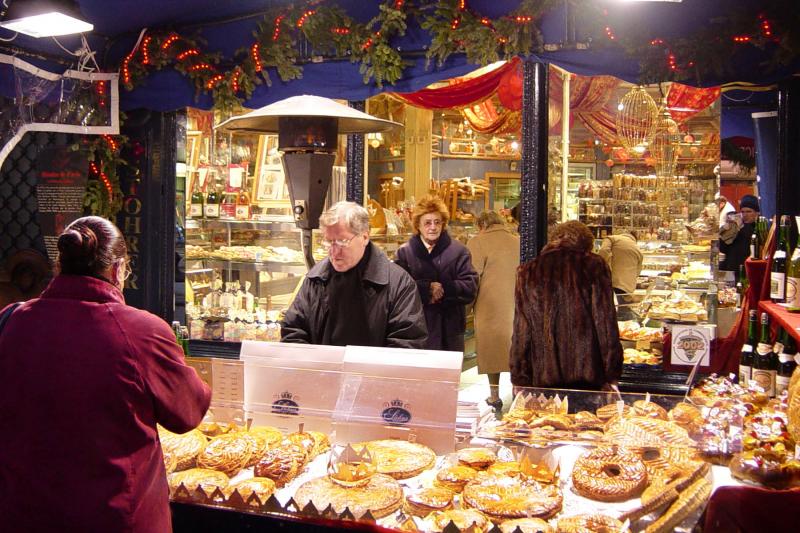Joyeux Noel: How France celebrates Christmas
Appears in the Online Edition, December 2018.
As it is in so many places, Christmas in France is all about family, friends and food. While it's generally a low-key affair marked by gatherings of relatives and treats for children, it also has the culinary high point of the year: Le Reveillon de Noel (Christmas Eve dinner).
The season officially starts on December 6 with a visit from St. Nicholas -- who arrives with a donkey carrying treat-filled baskets, a tradition still re-enacted in some villages. Over the centuries, the French merged St. Nicholas with Father Christmas to get Pere Noel. On December 25, Pere Noel travels in the company of Pere Fouettard, a wicked butcher who once tried to pickle some children. Nicholas rescued them, and now Pere Fouettard is doomed to follow around his better-behaved compatriot, helping deliver presents to French children.
French shoppers typically favor small specialty stores for gifts. In Paris, there are whole shops dedicated to foie gras, a traditional Christmas gift. Chocolate shops and patisseries get even more enticing this season. The streets are dotted with stalls selling all sorts of scrumptious food, including pain d'epice, a spiced honey bread.
A week before Christmas, French families display santons -- figurines that represent typical villagers, such as the doctor, the baker and the mayor -- with their Nativity scenes. A few days before December 25, Christmas trees are decorated with ornaments, candles, lights and tinsel. On Christmas morning, parents often add little toys, candies and fruits to surprise and delight their children.
On Christmas Eve, it's time for Le Reveillon de Noel feast. Reveillon literally means "awakening." In a symbolic sense, the Reveillon is a kind of spiritual bugler's reveille -- awakening people to the meaning of Jesus' birth.
Like most French dinners, the Reveillon lasts several hours -- including appetizers, main course, cheese plate and dessert -- all paired with wine. Each region of France serves special dishes for this feast: raw oysters in Paris, foie gras in Alsace, buckwheat cakes and sour cream in Brittany. The main course is usually roast goose or turkey.
The Reveillon dinner builds to the dessert, a cake called Buche de Noel (Yule Log Cake) that recalls some of France's earliest Yuletide traditions. Back in the 12th century, the Buche de Noel was an actual, very large, freshly cut tree, laid on the hearth. The family poured wine, oil and salt over the log while singing Christmas songs and offering prayers. Then the log was set ablaze, using a splinter saved from the previous year's Yule log. By the 19th century, as cast-iron stoves replaced large kitchen fireplaces, the Yule log was downsized to a small log decorated with candles and greenery.
Today, the Buche de Noel is a cake, often made of a rolled sponge cake, filled with a silky chocolate or chestnut buttercream, and covered in chocolate-buttercream "bark," with cocoa-dusted meringue "mushrooms" and almond-paste "holly leaves," all showered with confectioners' sugar to resemble snow.
Hours after the Reveillon begins, dozy uncles retire to armchairs while mothers round up eager and exhausted children for the last of the Christmas Eve rituals. In many homes, pajama-clad kids gather around the Christmas tree to sing a song or recite a poem for the family.
Just before bed, children all over France put their slippers by the fireplace or underneath the tree in hopes that Pere Noel will fill them with small gifts. In Burgundy, the children tuck an orange and a star-shaped cookie in their slippers to thank Pere Noel in advance for his generosity. Just before bed, children look out their windows for the "shepherd star" and place small candles on the windowsill to light the night while the sleeping world awaits the Nativity.
On January 6, France celebrates Epiphany -- the day the Three Kings delivered their gifts to Baby Jesus -- by eating Galette des Rois (French King Cake). In the north of France, galettes are round puff-pastry cakes, usually filled with almond frangipane. In Brittany, galettes resemble shortcake, and in the south of France, galettes are brioche decorated with candied fruit and flavored with brandy or orange-flower water. Inside each galette there is one lucky charm, usually a tiny porcelain figurine, ranging from Harry Potter to miniature Mona Lisa paintings. They're called feves, after the fava beans that were the original trinkets. Along with the feve, every galette is topped by a colorful paper crown. Traditionally, the galette is cut while the youngest child at the table designates who will get each piece, so there's no cheating. Everyone takes careful bites of the pastry until someone finds the feve. The winner gets the crown as well as the trinket, and becomes king or queen for the day.
After a month of celebrations, the French Christmas season hibernates for another year. Whether or not you make it to France this year, enjoy your friends, food and family this holiday season.
(Rick Steves (www.ricksteves.com) writes European travel guidebooks and hosts travel shows on public television and public radio. Email him at [email protected] and follow his blog on Facebook.)


